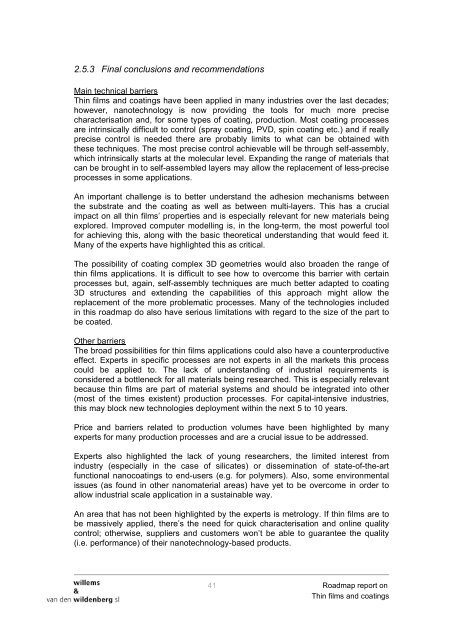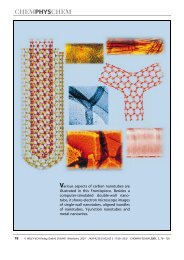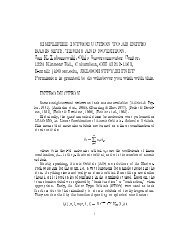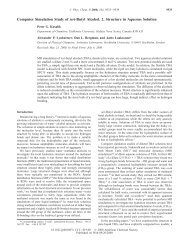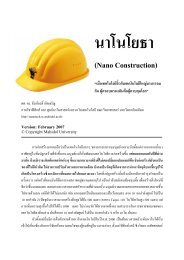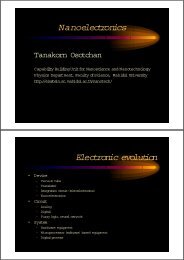'Thin films & coatings' Roadmap - Nano Mahidol
'Thin films & coatings' Roadmap - Nano Mahidol
'Thin films & coatings' Roadmap - Nano Mahidol
You also want an ePaper? Increase the reach of your titles
YUMPU automatically turns print PDFs into web optimized ePapers that Google loves.
2.5.3 Final conclusions and recommendations<br />
Main technical barriers<br />
Thin <strong>films</strong> and coatings have been applied in many industries over the last decades;<br />
however, nanotechnology is now providing the tools for much more precise<br />
characterisation and, for some types of coating, production. Most coating processes<br />
are intrinsically difficult to control (spray coating, PVD, spin coating etc.) and if really<br />
precise control is needed there are probably limits to what can be obtained with<br />
these techniques. The most precise control achievable will be through self-assembly,<br />
which intrinsically starts at the molecular level. Expanding the range of materials that<br />
can be brought in to self-assembled layers may allow the replacement of less-precise<br />
processes in some applications.<br />
An important challenge is to better understand the adhesion mechanisms between<br />
the substrate and the coating as well as between multi-layers. This has a crucial<br />
impact on all thin <strong>films</strong>’ properties and is especially relevant for new materials being<br />
explored. Improved computer modelling is, in the long-term, the most powerful tool<br />
for achieving this, along with the basic theoretical understanding that would feed it.<br />
Many of the experts have highlighted this as critical.<br />
The possibility of coating complex 3D geometries would also broaden the range of<br />
thin <strong>films</strong> applications. It is difficult to see how to overcome this barrier with certain<br />
processes but, again, self-assembly techniques are much better adapted to coating<br />
3D structures and extending the capabilities of this approach might allow the<br />
replacement of the more problematic processes. Many of the technologies included<br />
in this roadmap do also have serious limitations with regard to the size of the part to<br />
be coated.<br />
Other barriers<br />
The broad possibilities for thin <strong>films</strong> applications could also have a counterproductive<br />
effect. Experts in specific processes are not experts in all the markets this process<br />
could be applied to. The lack of understanding of industrial requirements is<br />
considered a bottleneck for all materials being researched. This is especially relevant<br />
because thin <strong>films</strong> are part of material systems and should be integrated into other<br />
(most of the times existent) production processes. For capital-intensive industries,<br />
this may block new technologies deployment within the next 5 to 10 years.<br />
Price and barriers related to production volumes have been highlighted by many<br />
experts for many production processes and are a crucial issue to be addressed.<br />
Experts also highlighted the lack of young researchers, the limited interest from<br />
industry (especially in the case of silicates) or dissemination of state-of-the-art<br />
functional nanocoatings to end-users (e.g. for polymers). Also, some environmental<br />
issues (as found in other nanomaterial areas) have yet to be overcome in order to<br />
allow industrial scale application in a sustainable way.<br />
An area that has not been highlighted by the experts is metrology. If thin <strong>films</strong> are to<br />
be massively applied, there’s the need for quick characterisation and online quality<br />
control; otherwise, suppliers and customers won’t be able to guarantee the quality<br />
(i.e. performance) of their nanotechnology-based products.<br />
41 <strong>Roadmap</strong> report on<br />
Thin <strong>films</strong> and coatings


